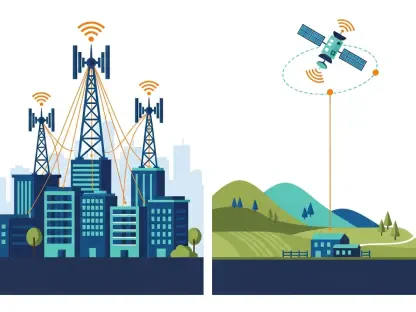Enterprise Telecom Expense Management (TEM) has undergone a remarkable transformation over recent years. Traditionally focused on managing fixed-line and mobile telecom expenses, TEM now encompasses a broader spectrum of services. The rise of the internet along with advanced technologies has greatly expanded its scope, turning it into a more data-driven, automated, and integrated approach. This shift is essential for thriving in today’s complex telecom environment, significantly changing how enterprises handle their telecom expenses.
The Rise of Data-Driven Decision Making
From Manual to Automated Processes
Historically, telecom managers heavily relied on manual processes to gather and analyze data related to telecom usage and expenses. These methods were not only time-consuming but also prone to errors, making it difficult to ensure accuracy and efficiency. Fortunately, the advent of automation and artificial intelligence (AI) has brought about a revolution in these processes. With real-time data now available, telecom managers can gain a clear and instant understanding of usage patterns and costs. This facilitates quicker and more precise decision-making, reducing the likelihood of errors and increasing operational efficiency.
The benefits of transitioning from manual to automated processes are manifold. Automation reduces the time spent sifting through data and minimizes human error, offering more reliable data analysis. Moreover, AI can identify patterns and anomalies that manual processes might miss, providing deeper insights that can guide cost-saving measures. Enterprises can now identify inefficiencies, track expenses more accurately, and make more informed decisions, ultimately leading to better management of telecom costs.
Benefits of AI and Automation in TEM
AI and automation have taken TEM to the next level by allowing rapid identification of billing errors and enabling enterprises to optimize their service plans and negotiate better rates with carriers. The level of accuracy and efficiency attainable with AI-driven processes is far superior to what was possible with manual methods. As a result, companies experience significant cost savings and operational efficiencies. Automated processes ensure that telecom managers can focus on strategic decision-making rather than being bogged down by routine data collection and analysis.
The integration of AI in TEM also offers predictive analytics, which can forecast future telecom expenses and usage trends. These insights help organizations prepare for upcoming changes and adjust their strategies proactively. For instance, AI can predict an upcoming spike in data usage during a particular period, allowing the company to renegotiate terms or shift resources accordingly. This predictive capability ensures that enterprises stay ahead of their telecom requirements rather than constantly playing catch-up.
Integrated Telecom Management
Transition from Isolated to Holistic Management
In the past, TEM solutions were designed to manage services such as voice, data, and mobile separately. This segmented approach often missed opportunities for savings and optimization that could only be identified through a comprehensive view. Modern TEM solutions have evolved to consolidate the management of all telecom services, adopting a holistic management approach that captures a complete picture of telecom expenses and usage.
The transition to integrated telecom management offers numerous benefits. By managing all telecom services together, enterprises can gain a broader understanding of their overall usage and costs. This consolidation makes it simpler to track and report expenses, streamlining operations and uncovering potential savings opportunities that were previously invisible under a segmented system. An integrated approach ensures that every aspect of telecom management is aligned, leading to better resource allocation and more strategic decision-making.
Advantages of an Integrated Approach
This integrated methodology enables organizations to uncover savings opportunities previously not apparent when telecom services were managed in isolation. It simplifies expense tracking and reporting, making it easier for companies to maintain accurate and up-to-date records of their telecom expenditures. By examining telecom expenses holistically, businesses can better understand their overall expenditure patterns and make informed decisions aimed at driving down costs and improving efficiency.
Moreover, an integrated approach to telecom management enhances operational transparency and accountability. When all telecom services are managed under one umbrella, it is easier to identify areas of inefficiency and address them promptly. This transparency ensures that all departments within an organization are aware of their telecom usage and expenses, promoting a culture of accountability. As a result, enterprises are better equipped to optimize their telecom infrastructure and achieve greater cost efficiencies.
The Importance of Cloud Expense Management
Expansion into Cloud Computing Costs
The surge in cloud computing usage has made it a significant aspect of corporate telecom expenditures. Modern TEM now extends its reach to managing cloud expenses, a natural progression for TEM experts already skilled in reconciling and managing recurring costs associated with traditional telecom services. Incorporating cloud expense management into TEM helps organizations avoid overpaying for cloud services and ensures that these costs are optimized just like any other telecom expense.
Managing cloud computing costs requires a different approach compared to traditional telecom services. Cloud services are often billed based on usage, which can be highly variable and difficult to predict. TEM solutions can help organizations monitor their cloud usage and expenses in real time, providing insights into areas where cost savings can be achieved. This ongoing monitoring is crucial for avoiding unexpected expenses and ensuring that cloud resources are being used efficiently.
Optimizing Cloud Usage and Costs
By incorporating cloud expense management into TEM, organizations can better monitor and optimize their cloud services. TEM solutions can identify areas where the company might be overpaying for cloud resources, enabling cost reductions and more efficient resource allocation. This ensures that cloud expenditures are as streamlined and cost-effective as other telecom services. In today’s digital age, where cloud computing plays a pivotal role in business operations, optimizing cloud expenses is essential for maintaining a competitive edge.
Effective cloud expense management also involves leveraging the data provided by TEM solutions to negotiate better terms with cloud service providers. Enterprises can use detailed usage reports and cost analyses to identify areas where they can negotiate discounts or more favorable terms. By presenting a comprehensive view of their cloud usage and expenses, organizations can strengthen their bargaining position and achieve significant cost savings. Additionally, TEM solutions can help identify opportunities for consolidating cloud services, further reducing costs and simplifying management.
Strategic Role of TEM
Beyond Cost Reduction
Traditionally, the primary focus of TEM was on cost reduction, aiming to minimize telecom expenses as much as possible. While cost reduction remains important, the role of TEM has expanded to encompass enhancing overall operational efficiency. Modern TEM helps organizations gain a deeper understanding of their telecom usage patterns, providing insights that go beyond mere cost-cutting. This strategic approach positions TEM as a crucial component of corporate telecom strategy, aimed at improving performance and reliability.
TEM’s expanded role involves leveraging data and insights to drive strategic decision-making. By understanding telecom usage patterns and trends, organizations can optimize their telecom infrastructure for better performance and scalability. This optimization goes hand in hand with cost efficiency, ensuring that enterprises get the most value out of their telecom investments. Rather than just focusing on cutting costs, modern TEM aims to enhance the overall effectiveness and reliability of telecom services, aligning with broader business objectives.
Enhancing Operational Efficiency
Understanding telecom usage patterns allows enterprises to make informed decisions regarding their telecom strategies. Instead of merely cutting costs, businesses can optimize their telecom infrastructure for better performance, reliability, and scalability. This strategic focus enables organizations to stay ahead of their telecom needs and adapt to changing requirements proactively. By leveraging the insights provided by TEM, enterprises can enhance their operational efficiency and ensure that their telecom infrastructure supports their business goals effectively.
Enhancing operational efficiency through TEM also involves fostering a culture of continuous improvement. Organizations that adopt a strategic approach to TEM are better equipped to identify areas for improvement and implement changes promptly. This continuous improvement mindset ensures that telecom services are always optimized for maximum efficiency and effectiveness. As a result, enterprises can maintain a competitive edge by staying ahead of their telecom requirements and adapting to new technologies and trends swiftly.
The Role of IoT in TEM
Integration with IoT Services
The rise of the Internet of Things (IoT) has introduced new complexities to telecom management. With the proliferation of interconnected devices, managing telecom expenses has become more challenging. Modern TEM solutions now incorporate IoT services, managing the connectivity and data usage of a multitude of interconnected devices. This integration ensures that IoT-related expenses are managed as efficiently as other telecom services, providing a comprehensive view of all telecom-related costs.
Managing IoT services involves monitoring the data consumption and connectivity of various devices, which can vary significantly depending on the use case. TEM solutions can provide insights into usage patterns, helping organizations identify areas where cost savings can be achieved. By incorporating IoT services into TEM, enterprises can ensure that their IoT deployments are cost-effective and efficient. This integration is crucial for managing the growing complexity of telecom expenses in an IoT-enabled world.
Managing IoT-Related Costs
Managing IoT-related expenses requires a different approach compared to traditional telecom services. IoT devices often generate vast amounts of data, leading to significant connectivity and data usage costs. TEM solutions can monitor the data consumption and connectivity of IoT devices, providing insights into usage patterns and potential cost-saving measures. This proactive approach ensures that IoT services are managed as efficiently as other telecom services, helping organizations avoid unexpected expenses and optimize their IoT deployments.
In addition to monitoring data consumption, TEM solutions can help organizations manage the lifecycle of IoT devices. This includes tracking the deployment, maintenance, and decommissioning of IoT devices, ensuring that they are used efficiently and cost-effectively throughout their lifecycle. By managing IoT-related expenses comprehensively, TEM solutions help organizations maximize the value of their IoT investments and avoid unnecessary costs.
Technological Advancements and Future Trends
Emerging Technologies in TEM
The ongoing evolution of TEM is fueled by continuous technological advancements. Emerging technologies such as machine learning and blockchain are poised to further transform TEM, offering new ways to optimize expenses and enhance transparency. Machine learning can analyze vast amounts of data to identify patterns and anomalies, providing deeper insights into telecom usage and costs. Blockchain technology offers a transparent and secure way to track telecom expenses, ensuring accountability and reducing the risk of fraud.
As these emerging technologies continue to develop, they will play an increasingly important role in TEM. Machine learning can help organizations predict future telecom expenses and usage trends, enabling proactive management and optimization. Blockchain can provide a tamper-proof record of all telecom transactions, enhancing transparency and trust. By leveraging these technologies, TEM solutions can offer even greater accuracy, efficiency, and transparency, helping organizations manage their telecom expenses effectively.
Preparing for Future Challenges
Enterprise Telecom Expense Management (TEM) has dramatically evolved in recent years. Initially, TEM was centered on managing costs associated with fixed-line and mobile telecom services. However, the landscape has profoundly changed with the advent of the internet and cutting-edge technologies. TEM now includes a wider array of services, making it much more comprehensive. This evolution means that TEM is now highly data-driven, automated, and interconnected, employing advanced analytics and automation to streamline processes.
The move towards a more integrated and automated system is crucial for businesses to navigate today’s intricate telecom environment. Enterprises today face a high volume of telecom expenses due to numerous devices, services, and international operations. As a result, a modern TEM approach is necessary to effectively control and optimize these costs. The shift in TEM practices allows organizations to not only manage expenses more efficiently but also to gain valuable insights through data analysis, improving overall decision-making. This transformation is vital for businesses aiming to stay competitive and fiscally responsible in an increasingly complex telecom landscape.









